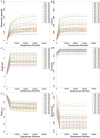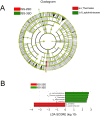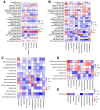The critical role of diet, exercise, and sleep in shaping the gut microbiota of children with idiopathic short stature: a Retrospective study
- PMID: 40821812
- PMCID: PMC12353712
- DOI: 10.3389/fimmu.2025.1566722
The critical role of diet, exercise, and sleep in shaping the gut microbiota of children with idiopathic short stature: a Retrospective study
Abstract
Objectives: To investigate the gut microbiota in children with varying degrees of idiopathic short stature (ISS) and to examine the relationship between their intestinal microbiota and lifestyle factors, including diet, exercise, medication, sleep, and psychological state.
Methods: A retrospective study involving 58 ISS children was conducted from May to October 2022. Lifestyle data were collected using questionnaires. Fecal samples were analyzed using 16S rRNA gene sequencing to assess microbiota diversity and composition. LEfSe analysis identified differential bacterial communities between ISS-2SD and ISS-3SD groups (LDA score ≥ 2.5). Spearman correlation analysis explored the relationship between microbiota diversity, dominant taxa, and lifestyle factors, visualized in a heatmap.
Results: No significant differences in alpha diversity of intestinal microbiota were observed among children with varying degrees of short stature at the ISS, but differences were noted in the dominant microbiota. The ISS-2SD group had Leptotrichiaceae and Sneathia as predominant members, whereas the ISS-3SD group was dominated by Lachnoclostridium, Thermous_scotoductus and Thermoles. Correlation analysis revealed that microbiota diversity was linked to diet, especially legume consumption (Shannon index: r=0.372, P=0.004; Simpson index: r=0.379, P=0.003). At the genus level, Prevotella was positively correlated with beverage intake (r=0.262, P=0.047) and sleep quality (r=0.324, P=0.013), while Ezakiella was negatively correlated with meat intake (r=-0.297, P=0.024), Other genera exhibited significant correlations with diet, exercise, and sleep.
Conclusion: Children with varying degrees of short stature exhibited differences in their dominant intestinal microbiota. Diet, exercise, and sleep appear to be significant factors influencing these microbial changes in ISS children.
Keywords: 16S rRNA gene sequencing; correlation analysis; idiopathic short stature; intestinal microbiota; lifestyle factors.
Copyright © 2025 Zeng, Zhu, Hu, Su and Chen.
Conflict of interest statement
The authors declare that the research was conducted in the absence of any commercial or financial relationships that could be construed as a potential conflict of interest. The Reviewer HZ declared a shared affiliation with the authors to the handling editor at the time of review.
Figures






Similar articles
-
Children with idiopathic short stature and growth hormone deficiency exhibit similar changes in gut microbiota.Endocr J. 2025 Jul 1;72(7):791-799. doi: 10.1507/endocrj.EJ24-0615. Epub 2025 Apr 5. Endocr J. 2025. PMID: 40189317 Free PMC article.
-
The association between gut microbiota composition and cardiometabolic parameters in healthy adults.BMC Microbiol. 2025 Aug 14;25(1):505. doi: 10.1186/s12866-025-04261-4. BMC Microbiol. 2025. PMID: 40813961 Free PMC article.
-
16S rRNA gene amplicon sequencing for microbiota analysis of rumen fluid, feces, and milk of Sarda sheep fed different contents of alfalfa hay (Medicago sativa).J Dairy Sci. 2025 Sep;108(9):10306-10324. doi: 10.3168/jds.2024-26172. Epub 2025 Jul 7. J Dairy Sci. 2025. PMID: 40633612
-
Effects of Exercise on Gut Microbiota of Adults: A Systematic Review and Meta-Analysis.Nutrients. 2024 Apr 5;16(7):1070. doi: 10.3390/nu16071070. Nutrients. 2024. PMID: 38613103 Free PMC article.
-
Gut microbiome-based interventions for the management of obesity in children and adolescents aged up to 19 years.Cochrane Database Syst Rev. 2025 Jul 10;7(7):CD015875. doi: 10.1002/14651858.CD015875. Cochrane Database Syst Rev. 2025. PMID: 40637175 Review.
References
-
- Bullinger M, Kołtowska-Häggström M, Sandberg D, Chaplin J, Wollmann H, Noeker M, et al. Health-related quality of life of children and adolescents with growth hormone deficiency or idiopathic short stature - part 2: available results and future directions. Hormone Res. (2009) 72:74–81. doi: 10.1159/000232159, PMID: - DOI - PubMed
MeSH terms
Substances
LinkOut - more resources
Full Text Sources
Medical

